Biweekly Budget Template: How To Create A Biweekly Budget
Inside: A biweekly budget is a budget that is broken into two-week periods. Learn how to create biweekly budgets and download your free template.
Many people create budgets, but only a few budget on a biweekly basis.
That is an interesting statistic because 43% of Americans are paid on a biweekly pay period (source).
So, the thought process is more people should be interested in learning knowing how to create a biweekly budget. But, in reality, most people give up on budgeting or move to a budget-by-paycheck method.
Recently, we moved over to a biweekly pay period. And thus, we quickly had to change how we focused on budgeting.
While most financial bloggers and gurus would agree, budgeting with biweekly paychecks makes the whole concept of budgeting hard.
While biweekly budgeting isn’t easy, it can be done!
This post will show you how to create an easy-to-manage and effective biweekly budget so that you can conquer your financial goals in the most efficient way possible!
We will go through the exact steps I use to create a biweekly budget to cover two weeks’ worth of expenses, get one month ahead on your bills, or adjust your planning to cover your monthly expenses.
This is a basic example, and you should use your own personal situation when developing your own budget.
Do you struggle to keep your finances on track? If so, here are some tips for creating a biweekly budget.
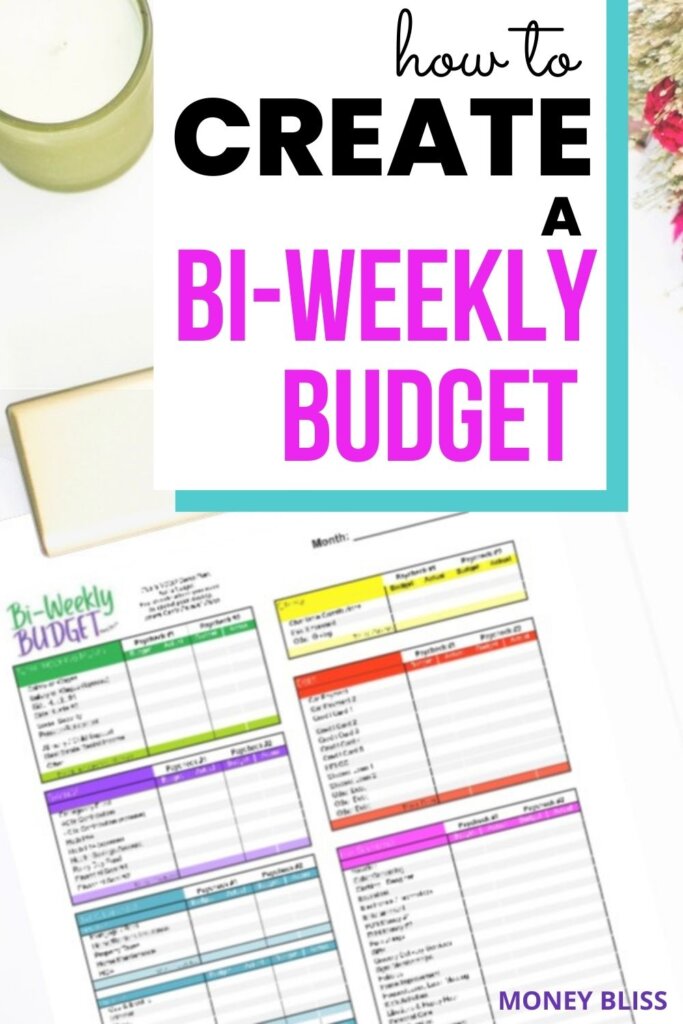
What is a biweekly budget?
A biweekly budget is a budget that takes into account a person collecting a paycheck every 14 days. This type of budget is beneficial for those who are paid on a biweekly schedule, as it allows them to plan their spending more effectively.
However, many people find it difficult when bills are due on a monthly basis.
Difference between biweekly and semi-monthly paychecks

When receiving paychecks twice a month happens with two types of pay schedules either biweekly or twice-per-month. The difference between these two schedules is the number of checks per year.
Those who are paid biweekly receive 26 checks per year, while those who are paid twice-per-month receive 24 checks per year.
Making a budget on a biweekly income can be difficult because the total number of checks received in a year varies depending on the pay schedule you have.
This post may contain affiliate links, which helps us to continue providing relevant content and we receive a small commission at no cost to you. As an Amazon Associate, I earn from qualifying purchases. Please read the full disclosure here.
Enjoy guilt-free spending and effortless saving with a friendly, flexible method for managing your finances.
How does a biweekly budget work?

A biweekly budget divides your budget into two parts, one for each paycheck that is received. This can be helpful for those who want to better track their spending or for those who want to save money.
It can be helpful to think of your biweekly budget as two separate budgets – one for bills and one for everything else.
When you create a biweekly budget, you are essentially creating two budgets over the span of ten months. Then, in the other two months, you will receive three paychecks; thus, need to create three budgets.
Since many monthly expenses remain the same when switching from a month budget to a biweekly budget, knowing which expenses should be increased or decreased beforehand can make the process smoother.
Additionally, it is helpful to know how much money you will need for each check. That way, you won’t have to worry about bouncing checks or accidentally overdrawing your account.
These are some of the components of successful budgeting.
How to create a biweekly budget

Creating a biweekly budget is a great way to start getting your finances in order. You can either create your own template or use one of the many templates that are available online for free.
One popular template is ours!
Money Bliss Biweekly Budget Template (see below to get your copy). This template is available as a free download and can be used in conjunction with our budget binder. The planner allows you to track your income and expenses, as well as financial documents such as bills and bank statements.
There are a few key things to keep in mind when creating a biweekly budget:
- Adjust your budget as needed.
- Be flexible when adjusting to this 2 week budget style.
- Compare your regular expenses to your spending from the past month.
Now, here are the steps to creating a biweekly budget that works.
Step 1: Print out a calendar
You need to print out the dates you get paid from your employer. On the biweekly paycheck, Fridays are usually pay dates; you just need to know which Fridays!
So, print out a blank calendar. Write down when you get paid along with when your bills and expenses are due.
This will help you get an idea of where you are spending your money and where you can cut back.
Many people find it helpful to color code by category and add stickers. This will help you see your budget at a glance.
Step 2: Put in a buffer

This will help ensure that you don’t have to worry about going into debt if something unexpected comes up.
Ideally, you should try to save at least two weeks’ worth of living expenses so that you know you’ll be able to cover your costs even if something goes wrong.
For us, all of our income goes into an “income checking” account. Then, at the beginning of the month, we transfer money into our “bills checking” to cover our expenses for the month.
Then, we always have at least one month of expenses on hand – just in case.
Step 3: Organize expenses
The easiest way to do this is by category. There are a few different ways to categorize your expenses, but the most common are:
- Fixed or recurring expenses: These are expenses that happen every month, like rent or utilities
- Variable or occasional expenses: These are expenses that happen each month but vary in amount, like groceries or entertainment
- Annual or quarterly expenses: These costs are less frequent, but take a good chunk of your budget like an annual insurance payment or kid’s sports fees
- One-time only expenses: These are one-time only costs and you don’t anticipate them again.
For most people, the struggle happens when organizing expenses. The expenses you “forgot” about are what blow your budget. Honestly, these are not forgotten expenses – just something you forgot to plan for.
Step 4: Focus on Zero Based Budgeting

Additionally, it’s important to use a zero-based budgeting approach.
With this method, you start by assigning every penny of income a job, whether it be for rent, groceries, or savings. This way, you can make sure that you’re not overspending each month.
A zero-based budget is a type of budget that starts with the assumption that there is nothing in your bank account.
This includes both predictable and unpredictable costs.
In the next steps, you will lay out what paycheck will cover what bills.
For example, some costs, like your rent or mortgage payment, will likely stay the same from one biweekly period to the next. By taking into account both types of expenses, you can get a more accurate picture of how much money you will need each pay period.
Learn more about zero based budgeting.
Step 5: Write your first biweekly budget
Writing a biweekly budget is the first step to creating financial stability. It’s important that you set up a plan for each paycheck to make sure your bills get paid.
When creating your first biweekly zero-based budget, you’ll want to start by paying your immediate obligations. This includes any bills or fixed expenses like rent or car payments that are due during the first pay period. After that, focus on covering your variable expenses such as groceries, gas, or eating out.
To make sure every dollar has a job, you should consider these tips:
- If you have any leftover money at the end of the month, send it to your savings or make extra debt payments.
- Make sure that each category in your budget has a specific amount assigned to it.
- Keep track of your spending so that you can stay on track and adjust as needed.
Paying your most important bills first is a crucial step in making sure that your finances are on track.
Find out the Verdict: Best Alternatives to Mint
Step 6: Write Your second biweekly budget

The second biweekly budget is a budget that’s typically created for the 2nd paycheck of the month. This budget would cover the next two weeks and may need to cover expenses at the beginning of next month before you get paid again.
Just like creating a budget plan for the 1st paycheck, you will do the same again. Prioritize any fixed expenses first, then add in variable expenses or sinking funds to contribute to.
In order to make your budget as accurate as possible, you should account for fluctuations in your expenses. This is where the buffer comes in – you put a certain amount of money aside each month to cover any unexpected costs. Then, you can start planning for them in the upcoming months.
Once again, if you have leftover money after budgeting for the two weeks, you can either send it to your savings account or start paying down your debt. If you choose to save, make sure that the money is in a place where it will earn interest and grow over time. If you choose to pay down debt, make sure that the payments are more than the minimum amount due so that you can see results quickly.
Step 7: Start tracking

Now that you have your biweekly budget template set up, it’s time to start filling in the numbers and track your budget. This part can be a little tricky, but with a little effort, you’ll be able to save money and get ahead on your debt payments.
First, take a look at your income and expenses for the month. How does this compare to what you’ve budgeted? If you’re coming in under budget in some areas, great! You can either use this extra money to bolster your savings or make extra debt payments. However, if you’re over budget in some areas, don’t worry – we’ll work through that below.
Next, take a look at your sinking funds.
These are accounts where you save money each month to cover specific expenses. How much money do you need to save each month in order to cover your bills? If you’re not sure, take a look at your past bills and use that as a guide. Once you know how much money you need to save, divide it by two and put that amount into your biweekly budget.
This will help ensure that you always have the money you need saved when the bill comes due.
If you have any leftover money after filling in your budget, send it to savings or make extra debt payments.
You can also use this extra money to invest in yourself (by taking classes, for example), but be careful not to overspend!
Creating and sticking to a biweekly budget is a great way to start saving money and getting your finances under control.
Are you looking for the best monthly budget planner to keep your finances organized?
Clever Fox Budget Book will help you keep your money organized, spend well, start saving, set and achieve financial goals.
It can help you to manage all your personal finances, savings, budgets, debt, payments, bills due, cash flow and expense tracking in 1 place.
Biweekly budgeting tips

When it comes to budgeting, biweekly budgets can be a helpful way to streamline the process. By taking an hour or so at the beginning of each month to set up your budget, you can avoid potential headaches down the road.
It’s also important to remember to write everything down! This includes both fixed and variable expenses.
Tip #1 – Change Due Dates of Bills
If you’re having trouble with your bills, don’t hesitate to call companies and ask them to change the due dates.
This is something I do whenever I open a new credit card. I want the credit card date to close at the end of the month.
Tip #2 – Age Your Money
You may also want to save up for one month’s worth of expenses so that you always have a cushion in case something unexpected comes up.
This is also the first step to stop living paycheck to paycheck.
When you have a cushion of savings, you’re less likely to fall into debt if something unexpected happens.
Tip #3 – Track Your 2 Week Budget

There are plenty of tools for budgeting out there. In fact, here are the best budgeting apps available.
It offers a variety of helpful tips for getting started, as well as ways to automate time-consuming tasks. With this tool, you’ll be able to improve your budgeting and financial insights in no time!
Many popular options include a budgeting app, Excel, or Google Sheets. Pick what works best for you
Tip #4 – Focus on Your Goals & Finances
In order to be successful, you’ll need to set financial goals for yourself and make plans to achieve them.
As with any other goal, it’s easier said than done! It can take a lot of time, work, and effort to reach your goal.
If you’re not sure where to begin or what goals are right for you, here are some examples:
- Pick a biweekly money saving challenge
- Save $5k in a year
- Not rely on luck with left hand itching
- Pay off your credit card debt in the next 18 months
- Learn how to double $10k quickly
This is just a sample of the types of goals you can set. If you’re not sure where to start, just think about what’s important to you and your family.
What are some financial goals that you have? Write down your goals and make a plan to achieve them.
What to avoid when you’re paid biweekly

When you’re paid biweekly, there are a few things you should avoid in order to make the most of your money.
You need to learn which payment type is best if you are trying to stick to a budget.
Since biweekly budgeting can be more difficult, you need to know the pitfalls to avoid.
Pitfall #1 – Spending All your Money Too Quick
First, don’t spend your money as soon as you get it. This will leave you with nothing left for the following two weeks.
When having to use one paycheck to cover most of your big expenses like mortgage/rent or insurance, that leaves very little money for groceries or gas
Try to have a savings goal and save for that.
For example, don’t wait until the end of the month to spend all your money. This can help you save more money and have something left over at the end of the month.
Pitfall #2 – Forgetting Bills

Second, don’t forget to budget for bills and other expenses. Make sure you have enough money to cover your costs, especially those non-frequent bills like car registration.
By doing this, you’ll be able to ensure that you have enough money each week to cover what you need.
Pitful # 3 – Quit Bi-Weekly Budget Completely
Yep, I get it budgeting your paycheck over a 2-week budget is difficult. It may feel like pushing a square through a circle. It takes a different mindset and a little more planning to make it happen.
If anything, try to avoid impulse buys. Wait until the next paycheck and see if you still want the purchase. That will help you not to overspend on unnecessary items.
What to do when you have a third paycheck?

This is the BEST benefit of a biweekly paycheck. Twice a year, you will receive 3 paychecks in a month instead of just two.
Looking forward to having a third paycheck, you can either save it or spend it.
If you save it, you can use it as a down payment on a house or invest it in a retirement fund. If you spend it, you can use it to pay down debt, remodel a house, buy a new-to-you car, or go on a vacation.
There are a few things you can do when you have an extra paycheck:
- Use it to pay down debt: If you have high-interest debts, using your third paycheck to pay them off can save you a lot of money in the long run.
- Get one month ahead on bills: This is great way to get ahead and your budget to work faster.
- Invest it: If you’re comfortable with taking on some risk, investing your extra paycheck could lead to bigger returns down the road.
- Sinking Funds: Those yearly expenses can weigh heavily on your budget. So, set extra money aside for those payments.
- Put the money towards your goals: Whatever your ambition is, here is money to help you get there faster.
- Spend it on something fun: Obviously, this isn’t the smartest option, but if you’ve been working hard and deserve a little treat, go for it!
Just make sure that you’re not spending more than you can afford. Thus, keeping you off a shoestring budget.
Free Printable Bi weekly Budget Templates
There are several different printable 2 week budget templates that can help you get your finances in order. Most of them are simple and easy-to-use, and they’re not scary to look at. In addition, many of them have templates that you can download and/or punch holes into so that you can use them as binders or notebooks.
One great option is the budget tracking worksheet. This cute template is simple yet effective, and it will help you track your spending each month.
How do you make a monthly budget with biweekly pay?

There are a couple of ways to make a monthly budget if you receive biweekly paychecks. You can either budget by paycheck, divide out your expenses between biweekly paychecks, or focus on a monthly budget.
If you choose to budget by paycheck, you’ll create a new budget for each pay period and then stick to it. This method gives you a better understanding of the flow of money in your bank account and will help you keep track of your bills more carefully.
The other option is to budget monthly, which is for people who live paycheck to paycheck. In this case, you would budget off 24 paychecks and make plans for your two budget paychecks. Then, two of your paychecks would be budgeted for the monthly budget.
However, many people argue the Budget-By-Paycheck method can help reduce stress since it allows for more flexibility.
In either case, you must track your spending throughout the month so that you can make adjustments as needed.
Time to Create Your Bi weekly Budget Calendar
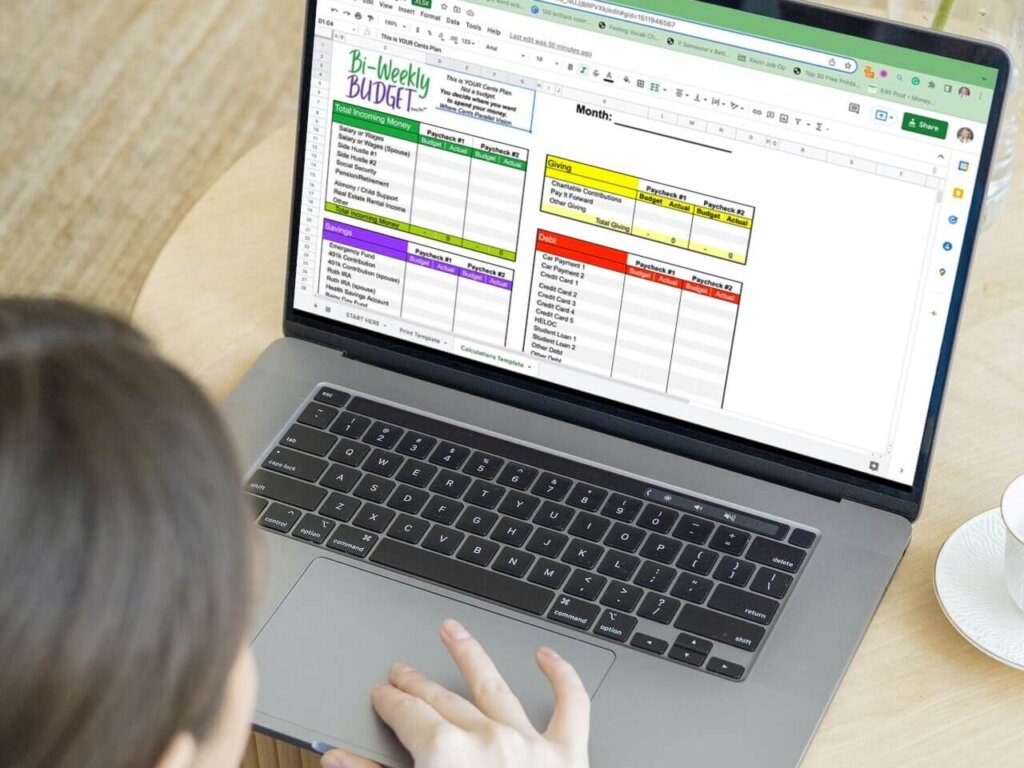
This budget will be a little more complicated than your monthly budget because your paychecks are not always going to be paid on the same day of the month. However, most of your bills are usually fixed and don’t change from month to month.
So, you need to plot out which bills you will pay with each paycheck ahead of time in order to make sure you have enough money to pay them all and keep them organized.
It is important to remember that when creating your budget, you need to give yourself some grace to make sure it works for you while you work on perfecting your budgeting style.
For us, having a buffer of money in our “income checking” account takes away the stress of bills and anxiety that we will run out of money. We understand that we need to use sinking funds for those variable expenses.
However, it is important to note that a biweekly budget tends to forget events such as birthdays or vacations from being considered in spending plans. So, make sure to include them.
Now that you have a good idea of how much money you make and how much money you need to live comfortably, it’s time to start creating your biweekly budget.
Also, taking time to understand your personal financial statement is important.
Did the post resonate with you?
More importantly, did I answer the questions you have about this topic? Let me know in the comments if I can help in some other way!
Your comments are not just welcomed; they’re an integral part of our community. Let’s continue the conversation and explore how these ideas align with your journey towards Money Bliss.

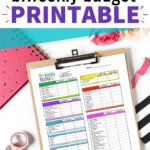



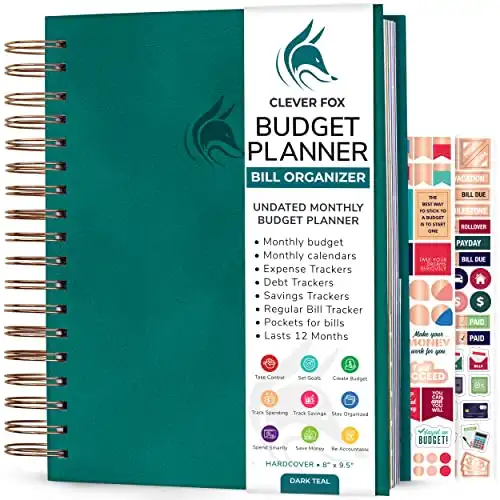
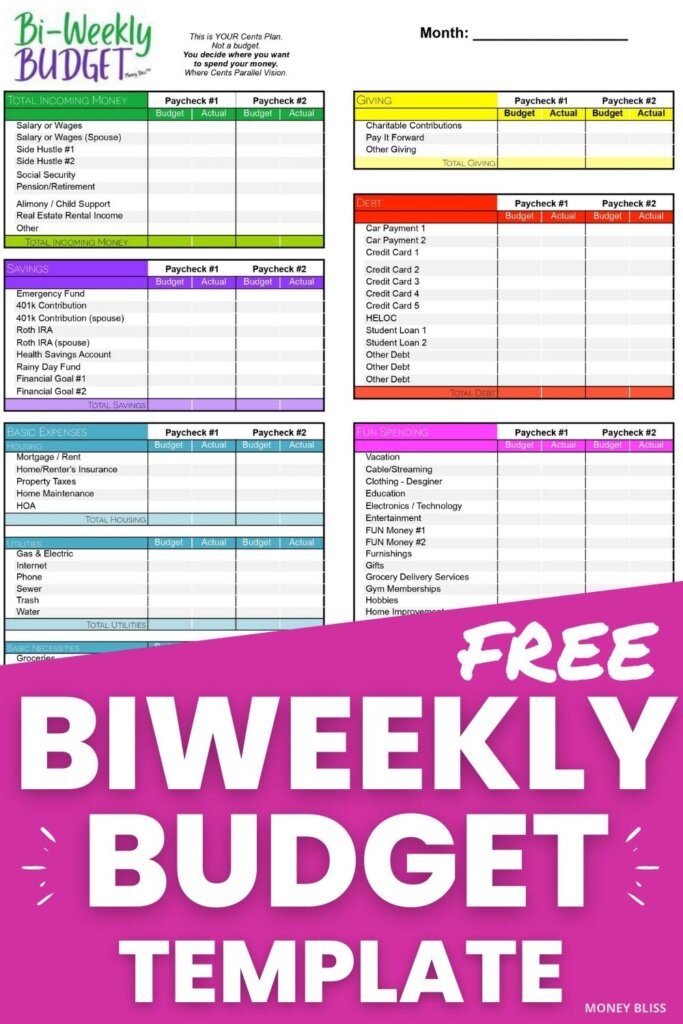

Hi, how can I get a copy of your free template for a biweekly planner?
Hi Charm,
Go here to subscribe to our email newsletter, which gives you access to the free templates. https://moneybliss.org/email-subscribe/
Hello! I love this article. I am trying to figure out how to subscribe so I can access the free printables and read more content. Can you tell me how im supposed to do that because I’m not seeing an option for it?
Hi Amber! I’m glad you found the content helpful. There are numerous places to join our community for access to printables and emails. This is probably the easiest way right now: https://moneybliss.org/email-subscribe/
Let me know if that works for you!
Would like the free printable sheet for the Biweekly Budget
The free printables are for my readers. Subscribe to our email list and you will get access to the budget printable and much more!
I Love The BI Week Template. My Husband Just Lost His Job. So This article Helped A lot. Thank You
I’m glad you enjoyed the template. Hopefully, it helps while you work through the job situation. In the meantime, you might want to look at ways to make money online to help with the transition.
how do I signup
Hi Teresa! There are numerous places to join our community for access to printables and emails. This is probably the easiest way right now: https://moneybliss.org/email-subscribe/